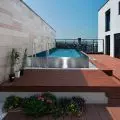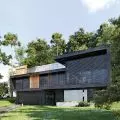A review of the book "Hydrozagadka. Who's taking Poland's water and how to get it back" by Jan Mencwel from A&B issue 10|23
Scythe, swamp, mozga, yarrow, valerian, rowan, fistula, reed. Alder, willow, pear. These species will become an integral part of the future landscape of our cities. We will make bouquets for our loved ones out of the scythers, or irises. If the areas where they grow are clean enough, and we learn the secrets of herbalism, we will cure colds with infusions from the flowers, and from the rhizomes we will create preparations to strengthen the body, including the liver. The valerian will come to our aid in nervous tension, the fistula will aid digestion, while the bloodroot will be a remedy for too heavy menstruation. Building the body's immunity will also be helped by the other mentioned plants. This will be possible as long as we take seriously the challenge of adapting to climate change, and consider concern for water as one of the main strategic challenges we currently face. Then these plants will join the catalog of familiar because common plants, such as milkweed, chestnut, rowan and nettle.
Jan Mencwel
Photo: Jakub Szafrański
The list of plants mentioned in the introduction are species recommended for urban plantings by Joanna Rayss, president of the Landscape Architecture Association, one of the protagonists of Jan Mencwel's "Hydrozagadka." Rayss runs the Zieleniarium studio, which designs, among other things, rain gardens on housing estates. Their introduction is both a design and aesthetic challenge. Indeed, Mencwel writes about one of the Gdansk housing estates where such a solution has been applied: "At first glance, the housing estate looks as if someone had... boxed it in" (p. 282). However, while we may have different approaches to aesthetics, the water balance is obvious. Greenery designed in this way copes much better in a situation of water shortage or excess. Joanna Rayss shows that we should look at design through a simple accounting balance: owe - have. And ask ourselves the following questions: how much water drains into the sewer system?How much is needed to maintain the plants? How do we design the site to ensure both savings and safety?
The system for draining water from the Konin Lignite Mine in Tomislawice
photo: Jakub Szafrański
Renaturalization as a new modernization?
Adapting to climate change requires us to change our thinking, but not necessarily to invent new solutions. "Hydrozagadka. Who's taking Poland's water and how to get it back" is a story about the modernization vision that led to the current water crisis. Mencwel shows that water management is nothing new; moreover, water has been part of many modernization projects and accompanying visions of a better life. The direction of these changes, however, was the opposite of what it is now. Modernity in its various guises was associated with taming the element of water. We see it in the novels of both Żeromski, Dąbrowska and the intellectual elite, who, in creating their vision of an independent Poland, were obsessed with water. Excess water, especially when combined with earth and disguised as mud, had to be tamed. "The mud, the swamp, the wild river - that is, water in its untamed form, flowing or oozing freely, uselessly, without human control - became a symbol of our backwardness" (p. 76). We could catch up with the West only by draining Poland. And this meant cities or villages, but also such areas as the Kurpie wetlands.
A dried-up ditch irrigating farmland in Poznań
photo: Jakub Szafrański
The vision of modernization as a struggle against the element of water has recurred as a cyclical developmental motif in various regimes. It has had its independence, fascist, communist and capitalist iterations. These include both massive dams on the Vistula, modernization of riverbanks, and urban "concretosis," which became the title character of Mencwel's previous book. The fear of mud as the combined elements of water and earth, which are traditionally identified with feminine energy, caused an obsessive need for control. Mud and wetness are contrasted with a fit, resilient male body (p. 87). As history shows, attempts to tame the elements sooner or later end in disaster. It is far better to cooperate with nature than to compete, and instead of a vision of modernization lined with fear of nature in its various guises, to move toward symbiotic cooperation. Here the democratization of societies and emancipation in the broadest sense go hand in hand with sustainable development.
A funeral march for the Oder River in August 2022 on the Vistula Boulevards in Warsaw.
photo: Jakub Szafrański
Not surprisingly, the current growing respect for water as a resource and concern for self-regulating natural systems goes hand in hand with the ecofeminist revolution. One of its offshoots is a project launched by Cracow-based artist Cecilia Malik - Sisters of the River. This women's collective, as Mencwel points out, was formed "against plans drawn up in political offices by gentlemen in suits" (p. 195). Its goal is to defend Polish rivers. The first of these is the Białka, a tributary of the Dunajec River. The next are the Narew, Pilica, Przemsza, Bzura, and Raba. Cecilia Malik's actions are artistic performances whose purpose is openly political. Here, the rivers gain subjectivity and are not just an element of nature, but a loved one whose rights should be fought for. This is a very different approach to the vision of modernization than the one we have known. The next step is to fight for the rights of the Oder, which we will also read about in the pages of "Hydrozagadka."
The Bug River in Drohiczyn
photo: Jakub Szafrański
designing with water and water
"Hydrozagadka" is a journey through Poland in the footsteps of bad modernization, water mainstays and projects that lean us towards a sustainable future. Mencwel shows us contemporary examples of solutions - both urban and away from cities. After reading this book, it becomes obvious that the appearance of our neighborhoods must change - it's no longer just a shift from a landscape where rows of thuyas punctuate evenly trimmed lawns and paved sidewalks, toward more biodiverse plantings. The next step is to recognize that concern for water retention is one of the most important planning guidelines. And this is where de-concretizing cities may not be enough. There is a need to adapt the landscape to actively respond to water challenges - this includes both active expectation of water, i.e. the creation of retention basins of various sizes: these can be rain barrels, neighborhood ponds (it's at these that bleeding, mozzy, rowan and alder trees will grow), as well as other architectural solutions that save cities from flooding. An important role is played by marshes, bogs, moors, quagmires, unregulated river banks.
The natural course of the Omulew River near the village of Gleba in the municipality of Kadzidlo
Photo: Jakub Szafrański
This challenge applies not only to cities, but also to villages. Mencwel leads us on a visit to Snowidowo, a village famous for its effective water retention. It was heard of this summer as a "green spot on the red map," the only place in Greater Poland that emerged unscathed from the May-June drought. It's all thanks to mid-field plantings taken care of by a local farmer, Patrick Kokocinski. As Mencwel describes it, "A strip of tree plantings runs through the middle of the field, with water spilling out around them. It forms a buffer strip, a few meters in each direction. Patrick began damming the water in the nearby canal several years ago. Now the water is standing, soaking the ground, and you can feel the effects in the soil all over the field. Yes, this means that Patryk has less acreage to cultivate. He has to sacrifice a piece of the field, he won't get with the crop to the very edge of the canal" (p. 289). However, with better irrigation, yields are higher. It might seem like a distant topic from an urban perspective, but droughts are a threat to our food security and higher food prices.
Gugny-Barwik walking trail on the Biebrza River and the cover of the book "Hydrozagadka"
photo: Jakub Szafrański
Looking from the perspective of water makes the line between what is urban and what is non-urban blur. The principles of designing with respect for water and concern for its presence are similar here - it is worth letting nature lead the way. In turn, the measure of success will be the complexity of the natural ecosystem, including the presence of birds - signalers of changes in water relations.
"Hydrozagadka" shows that when thinking about the cities of the future, it is necessary to go beyond designing for people and know that the guarantee of the height of the quality of life, is to actively remember that we are part of a larger ecosystem. Urban resilience and our health go hand in hand and can support each other all the more strongly the more effectively we embark on the path of sustainability and begin to see ourselves as part of a larger natural ecosystem.
Joanna ERBEL
photo: Jakub Szafrański
© Krytyka Polityczna Publishing House













































